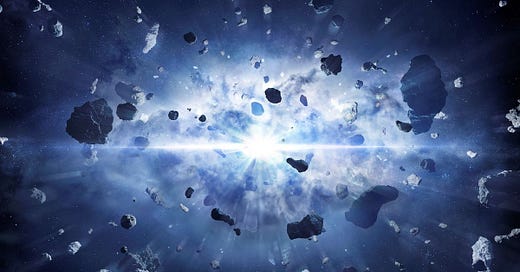The notion of "pure energy" occupies a mystical corner of modern physics, evoking an era of cosmic infancy where the familiar constructs of matter were entirely absent. This ephemeral chapter, known as the Planck Epoch, represents a moment in time when the cosmos was a crucible of extreme forces and surreal conditions. Here, we embark on an exploration of this enigmatic phenomenon, its role in shaping the universe, and its enduring implications for scientific inquiry
.
Decoding "Pure Energy": An Elusive Concept
Within the framework of the Big Bang theory, "pure energy" denotes a primordial state of existence devoid of matter, photons, or even the simplest particles. It epitomizes an abstraction of energy in its most compressed and intense form, a concept underscored by Einstein's iconic equation, E=mc², which reveals the fluid interchangeability of mass and energy.
In the first fleeting moments post-Big Bang, the universe was unimaginably compact, with temperatures soaring beyond 103210^{32} Kelvin. In such conditions, the conventional dichotomy between matter and energy collapsed, leaving only profound energy fields pulsating through the nascent universe.
The Planck Epoch: A Realm of Primal Energy
A Snapshot of the Planck Epoch
Spanning from zero to 10−4310^{-43} seconds, the Planck Epoch marks the uncharted frontier of our understanding of the cosmos. This interval, governed by inconceivably high energies and densities, transcends the explanatory power of contemporary physics. Key characteristics of this epoch include:
Unified Fundamental Forces: Gravity, electromagnetism, and nuclear forces coalesced into a singular, indistinguishable entity.
Quantum Turbulence: Space-time itself ebbed and flowed with quantum uncertainties, forming a dynamic "quantum foam."
During this phase, the cosmos was a chaotic ocean of fluctuating energy fields, where no particles, atoms, or even photons could yet emerge. The very fabric of reality was in a constant state of flux, with energy manifesting as ephemeral ripples in an unfathomable quantum sea.
Why Was Matter Absent in This Era?
Matter, as we comprehend it, emerges when energy stabilizes into particles, a phenomenon governed by a process known as symmetry breaking. However, in the searing environment of the Planck Epoch, with its immense pressures and temperatures, energy lacked the stability required to coalesce into particles like quarks or electrons. Instead, the universe churned with raw energy, perpetually transforming and interacting at infinitesimal timescales.
From Energy to Matter: A Cosmic Transition
The Grand Unification Epoch
As the universe expanded and began to cool, it transitioned into the Grand Unification Epoch, lasting from 10−4310^{-43} to 10−3610^{-36} seconds. During this period, the intense heat subsided marginally, enabling the strong nuclear force to separate from the unified forces. This decoupling signified the first steps toward forming particles, albeit ones that were highly unstable and transient.
Quark-Gluon Soup: The Precursor to Matter
By approximately 10−1210^{-12} seconds after the Big Bang, the universe's temperature dropped to roughly 101510^{15} Kelvin. This cooling allowed quarks and gluons—fundamental building blocks of matter—to combine and form protons and neutrons. The transition marked the birth of matter as we know it, a transformative moment that heralded the beginning of the material universe.
Theoretical Reverberations of Pure Energy
The enigmatic nature of pure energy continues to inspire profound scientific questions, offering glimpses into the origins and mechanics of the cosmos. Key theoretical implications include:
Toward a Unified Theory
The study of pure energy during the Planck Epoch could bridge the chasm between general relativity and quantum mechanics, paving the way for a comprehensive "Theory of Everything."Quantum Seeds of the Universe
Fluctuations within the primordial quantum foam may have planted the seeds for the large-scale cosmic structures we observe today, from galaxies to solar systems.Insights into Dark Energy
Although distinct from the dark energy driving the universe's expansion, understanding pure energy could illuminate the properties and origins of this mysterious force.
Does Pure Energy Exist in the Present Day?
In the current epoch, the pristine state of pure energy that dominated the early universe no longer exists in its original form. Nonetheless, scientists have recreated analogous conditions in particle accelerators, such as the Large Hadron Collider (LHC). By simulating the extreme energies present just fractions of a second after the Big Bang, these experiments provide valuable insights into the universe's infancy and the transition from energy to matter.
Concluding Thoughts: The Legacy of Pure Energy
The concept of pure energy encapsulates the essence of creation, serving as the progenitor of all matter and forces in the cosmos.
It highlights the intricate interplay between quantum mechanics and cosmology, offering a window into the universe's earliest moments.
By delving into this phenomenon, we not only unravel the mysteries of our origins but also lay the groundwork for understanding the cosmos's ultimate destiny.
Pure energy, though no longer observable in its primeval state, remains a cornerstone of theoretical physics, challenging us to expand the horizons of human knowledge and imagination.





